NCERT Solutions for Class 7 Social Science Chapter 7 The Gupta Era: An Age of Tireless Creativity
The Big Questions (Page 145)
Q1: Who were the Guptas? Why is the Gupta period sometimes called the ‘classical age’ in Indian history?
Ans:
- The Guptas were a powerful dynasty that ruled much of north and west India from the 3rd to 6th century CE.
- Their rule brought peace, prosperity, and progress in fields like science, art, and literature.
- This period is called the Classical Age because it saw the rise of great scholars like Aryabhata, Kalidasa, and beautiful art in places like Ajanta and Udayagiri.
- The Guptas promoted learning, trade, and religious harmony, setting high standards for Indian civilisation.
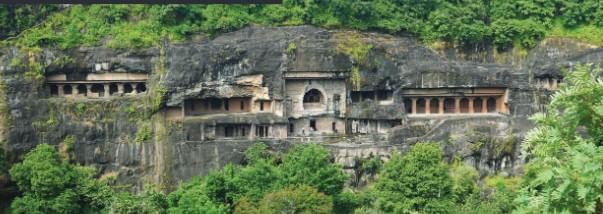 Landscape of Ajanta CavesQ2: What was happening in the rest of the subcontinent at this time?
Landscape of Ajanta CavesQ2: What was happening in the rest of the subcontinent at this time?
Ans:
- In south India, the Pallavas became powerful and built temples in Kanchipuram, a major center of learning.
- In the northeast, the Kamarupa kingdom (modern Assam and Bengal) rose, known for temples and monasteries.
- These kingdoms had their own rich cultures, even while the Guptas ruled the north.
- The Gupta emperor Samudragupta defeated many southern and northeastern rulers but allowed them to continue as tributary states.
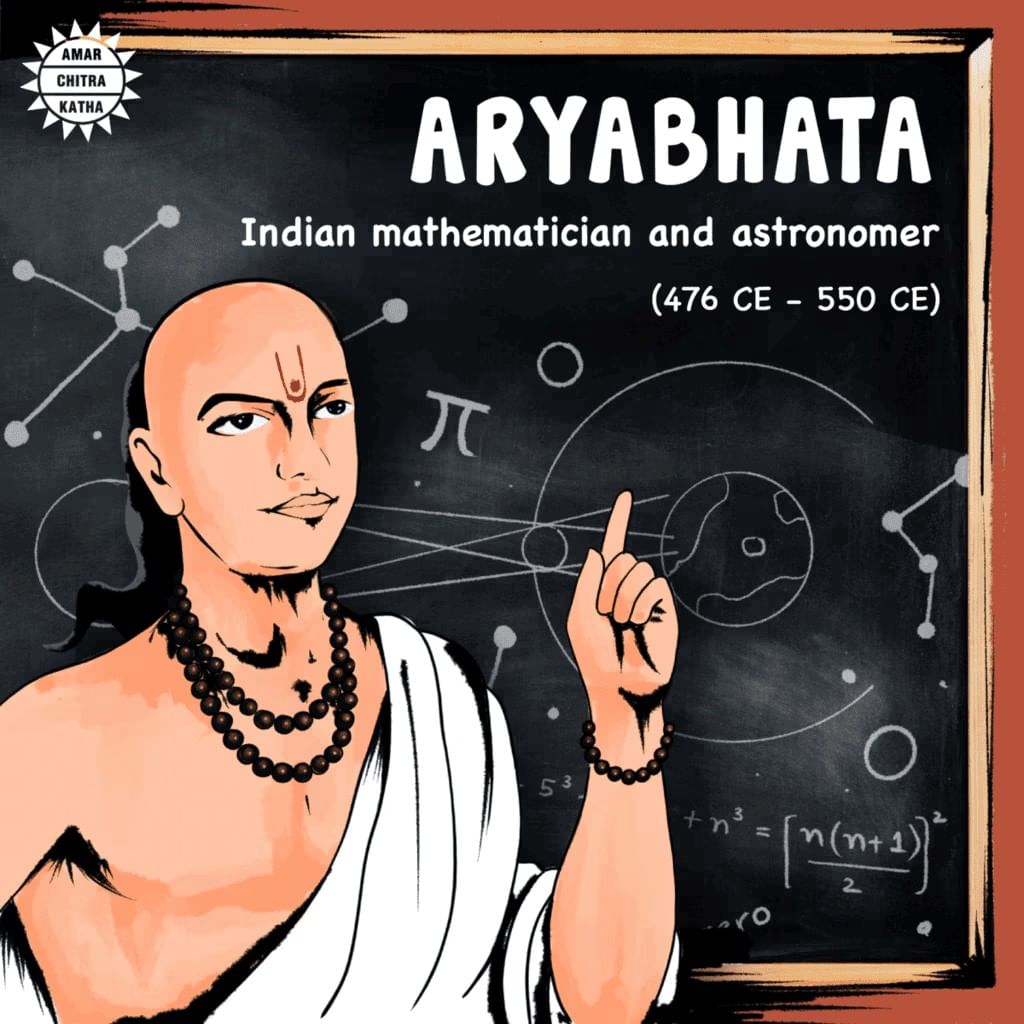 Q3: Who were some great figures of this period, and why do their stories matter today?
Q3: Who were some great figures of this period, and why do their stories matter today?
Ans:
- Aryabhata, a scientist, explained day and night, eclipses, and calculated the Earth's size and the year’s length with great accuracy.
- Varahamihira was an expert in astronomy, town planning, weather, and farming, combining science with observation.
- Kalidasa, a poet, wrote famous works like Meghadutam, admired for their beauty and emotion.
- Their contributions in math, science, literature, and art still influence Indian and world culture today.
Back Questions (Page 165 & 166)
Q1: Imagine you receive a letter from someone living in the Gupta Empire. The letter starts like this:
“Greetings from Pāṭaliputra! Life here is vibrant and full of excitement. Just yesterday, I witnessed …” Complete the letter with a short paragraph (250–300 words) describing life in the Gupta Empire.
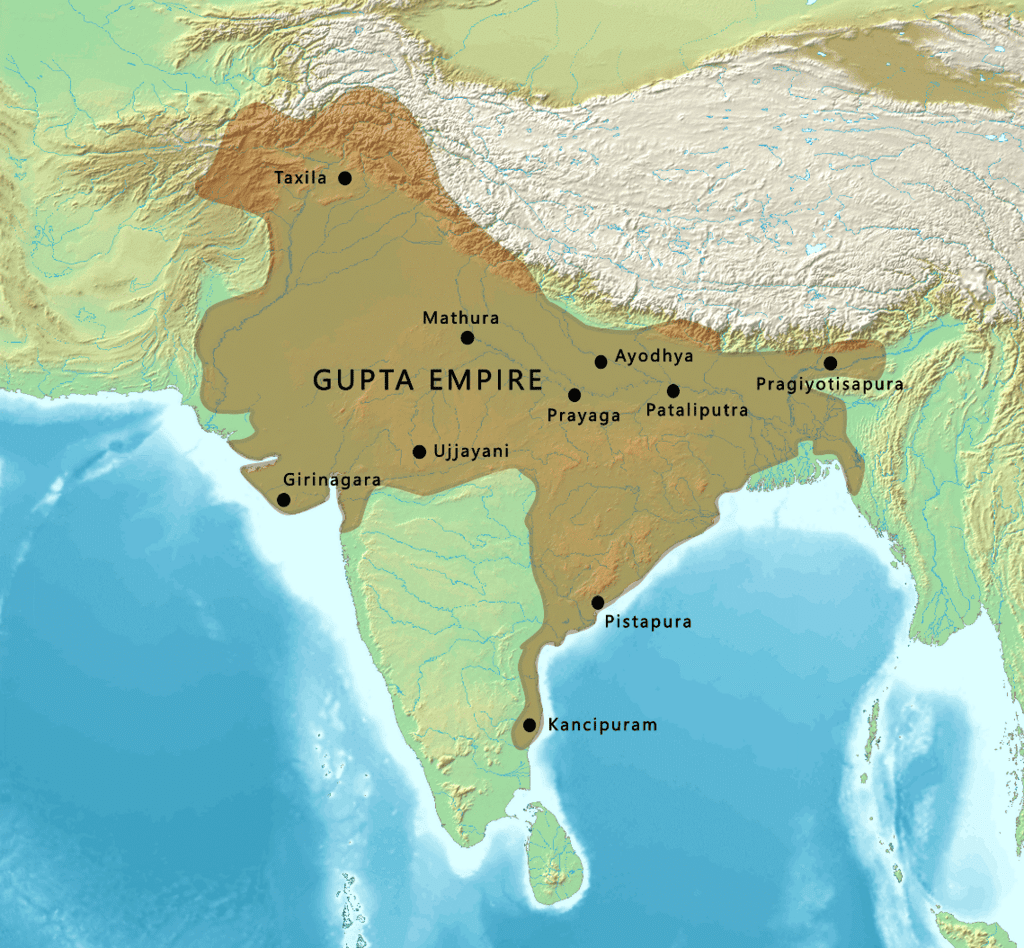 Gupta EmpireAns: Dear Friend,
Gupta EmpireAns: Dear Friend,
Greetings from Pāṭaliputra! Life here is vibrant and full of excitement. Just yesterday, I witnessed a grand religious procession that passed through the streets. The people were singing songs in praise of Lord Vishnu, and it was truly magnificent to see so many people coming together in such a joyful celebration. The streets were bustling with traders selling fine silk, spices, and beautiful jewelry, many of which are imported from faraway lands. The markets are always filled with life, with people coming and going, bargaining, and sharing news.
The Gupta Empire is known for its peace and prosperity, and we feel safe here under the rule of our wise king, Chandragupta II, who is also known as Vikramāditya. He encourages learning and supports scholars, poets, and artists. Just yesterday, I visited the Nalanda University to meet some scholars and listen to their teachings on astronomy and mathematics. The buildings here are majestic, and the architecture is truly inspiring. Our cities are well-planned, with wide roads, beautiful temples, and magnificent caves carved into the hills, like the Ajanta Caves.
Life in the Gupta Empire is peaceful and flourishing. Education is highly valued, and we are fortunate to be part of this golden age of knowledge and art. I hope you can visit someday to see it for yourself!
Warm regards,
[Your Name]
Pāṭaliputra
Q2: Which Gupta ruler was also known as the ‘Vikramāditya’?
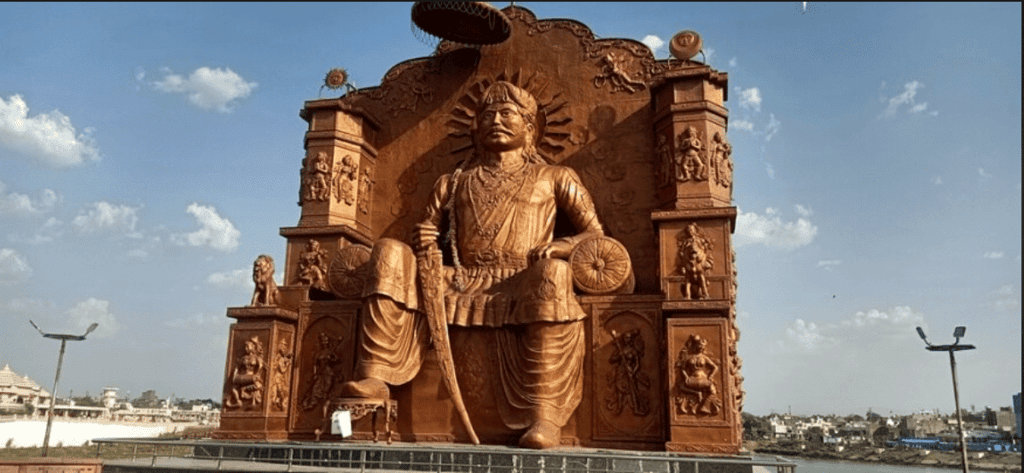 King VikramadityaAns: The Gupta ruler who was also known as ‘Vikramāditya’ was Chandragupta II. He was one of the greatest rulers of the Gupta dynasty and is renowned for his military successes, his patronage of the arts, and his contributions to the growth of culture and knowledge. The title Vikramāditya, which means "the Sun of Valor," reflects his achievements as a warrior king and his role in promoting peace, culture, and education in the empire.
King VikramadityaAns: The Gupta ruler who was also known as ‘Vikramāditya’ was Chandragupta II. He was one of the greatest rulers of the Gupta dynasty and is renowned for his military successes, his patronage of the arts, and his contributions to the growth of culture and knowledge. The title Vikramāditya, which means "the Sun of Valor," reflects his achievements as a warrior king and his role in promoting peace, culture, and education in the empire.
Q3: “Periods of peace support the development of various aspects of sociocultural life, literature, and the development of science and technology.” Examine this statement in the light of the Gupta empire.
Ans:
- The Gupta Empire is a prime example of how periods of peace can support sociocultural development. During the reign of Chandragupta I, Samudragupta, and Chandragupta II, the Gupta Empire enjoyed a long period of stability and peace. This peaceful environment allowed people to focus on activities other than war and conflict, such as art, literature, science, and commerce.
- In terms of literature, this period saw the creation of some of the greatest works of Sanskrit literature, including the writings of Kālidāsa (such as the famous play Shakuntala), and the Puranas, which helped preserve ancient knowledge and cultural practices.
- The Gupta period also marked great advancements in science and mathematics. Āryabhaṭa, a famous mathematician and astronomer, made significant contributions, such as calculating the length of a year and proposing that the Earth rotates on its axis. The peaceful society also allowed for developments in metallurgy, as evidenced by the Iron Pillar of Delhi, which remains rust-free after more than 1,600 years.
- Thus, peace in the Gupta Empire allowed for the flourishing of intellectual pursuits and the advancement of technology, leaving a lasting impact on the world.
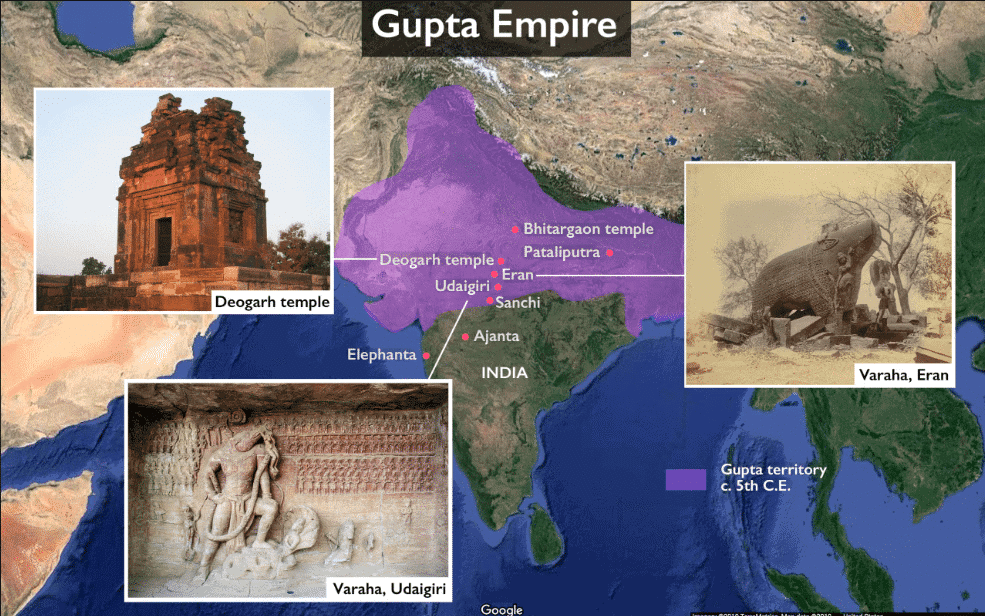 Gupta Empire
Gupta Empire
Q4: Recreate a scene from a Gupta ruler’s court. Write a short script, assign roles like the king, ministers, and scholars, and enact a role play to bring the Gupta era to life!
Ans: Title: A Day at the Gupta King’s Court
Scene: The grand court of Chandragupta II (Vikramāditya), decorated with rich tapestries, statues, and beautiful architecture.
Roles:
Chandragupta II (King)
Prime Minister (Mantri)
Court Poet (Kavi)
Scholar (Vidyapati)
General (Senapati)
Merchant (Vyapari)
[The scene opens with the king sitting on his throne, surrounded by his ministers and scholars.]
Chandragupta II: Welcome, my learned scholars and advisors! Today, I seek to hear of your latest findings. Kavi, what new poetic works have you composed?
Kavi: O King, I have composed a new poem that praises the beauty of the kingdom. It describes the Ajanta Caves, the Ganga river, and the prosperous markets where trade flourishes. I would be honored to present it.
[The poet recites the poem.]
Chandragupta II: Very well, Kavi. Your words are as beautiful as the land we rule. Vidyapati, I hear you have been studying the stars. What new knowledge have you gained?
Vidyapati: Your Majesty, I have been studying the movement of planets and astronomical patterns. Our great mathematician, Āryabhaṭa, has helped us understand the solar system better. I believe that astronomy will become the cornerstone of future scientific advancements.
Chandragupta II: Excellent. Your studies will guide future generations. Senapati, what news do you bring from the border?
Senapati: O King, the borders are peaceful. We have had no trouble with invaders, and our alliances with neighboring kingdoms are strong. The people are at peace, and trade is flourishing.
Chandragupta II: Wonderful. We must continue to promote peace and the prosperity of our empire. Merchant, tell us about the trade with foreign lands.
Merchant: Your Majesty, the trade with Rome, China, and the Mediterranean is thriving. We export textiles, spices, and ivory, while we import glass, gems, and wine.
Chandragupta II: Let us continue to support our traders and artists, for they bring wealth and culture to our empire. Keep up the good work, everyone.
[The scene ends with the court in agreement, and the king nodding in satisfaction.]
Q5: Match the two columns:
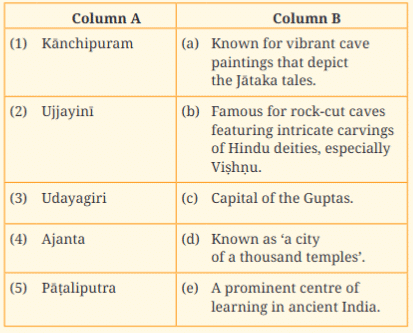
Ans:
(1) Kānchipuram → (d) Known as ‘a city of a thousand temples’.
(2) Ujjayinī → (e) A prominent centre of learning in ancient India.
(3) Udayagiri → (b) Famous for rock-cut caves featuring intricate carvings of Hindu deities, especially Viṣhṇu.
(4) Ajanta → (a) Known for vibrant cave paintings that depict the Jātaka tales.
(5) Pāṭaliputra → (c) Capital of the Guptas.
Q6: Who were the Pallavas and where did they rule?
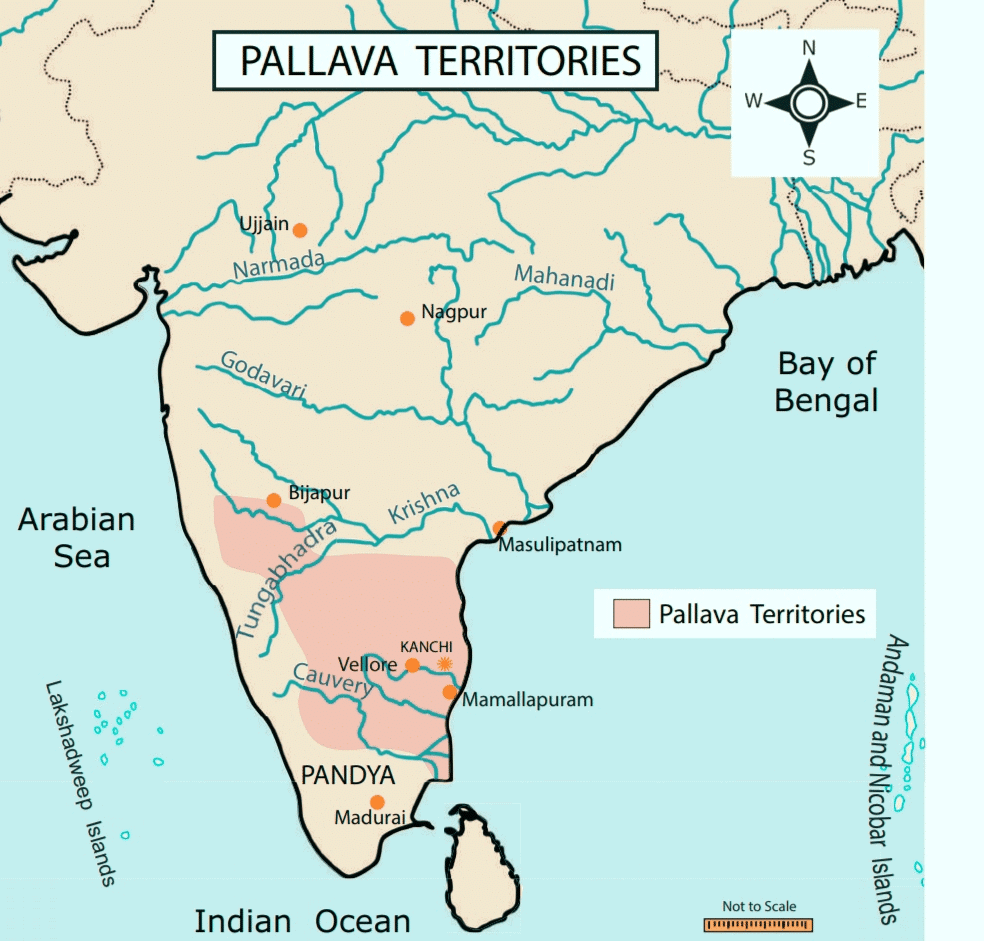 Pallava Empire
Pallava Empire
- The Pallavas were a powerful dynasty that ruled over parts of Southern India, particularly in the region of modern-day Tamil Nadu, Karnataka, and Andhra Pradesh.
- They emerged after the decline of the Sātavāhana dynasty and played a significant role in the history of South India. Their capital was at Kanchipuram, which was a renowned center of learning and art.
- The Pallavas were great patrons of art and architecture, and many of the magnificent temples and rock-cut caves associated with the Pallavas still stand today. They were also known for their contributions to Indian literature and education.
Q7: Organise an exploration trip with your teachers to a nearby historical site, museum, or heritage building. After the trip, write a detailed report describing your experience. Include key observations about the site’s historical significance, the architecture, artefacts, and any interesting facts you learned during the visit. Reflect on how the trip enhanced your understanding of history.
Here is one Sample Report:
Ans: Sample Report: Exploration Trip to the Qutub Minar
- Introduction: On the 10th of August, 2025, our class, accompanied by our teacher, went on an educational trip to the Qutub Minar, located in Mehrauli, Delhi. The Qutub Minar is one of India’s most famous and significant historical sites. It is a UNESCO World Heritage site, and this visit was a unique opportunity to experience firsthand the grandeur of this monument. The purpose of the trip was to explore the historical significance, architecture, and artefacts related to the Qutub Minar, as well as to deepen our understanding of the medieval period of Indian history.
- Historical Significance: The Qutub Minar was built by Qutb-ud-Din Aibak, the first ruler of the Delhi Sultanate, in the early 13th century. It stands as a symbol of the establishment of Muslim rule in India. The minar is 72.5 meters tall, making it the tallest brick minaret in the world. It is also significant because it marks the beginning of the Indo-Islamic architectural style in India. The Qutub Minar is not just a beautiful structure but also a testament to the architectural prowess of that era. It is believed to have been constructed to commemorate the victory of the Delhi Sultanate over the last Hindu kingdom of Delhi.
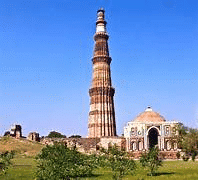 Qutub Minar
Qutub Minar
- Architecture and Design: The Qutub Minar is an extraordinary example of Indo-Islamic architecture. The minaret is made of red sandstone, and its intricate carvings feature verses from the Quran, making it not only an architectural marvel but also an artistic one. The base of the minar is wide, and it tapers as it rises, with five distinct stories, each separated by balconies. The architecture showcases Persian, Afghan, and Turkish influences, blending these elements with indigenous Indian styles. The intricate calligraphy on the walls, along with floral patterns, added to the beauty and elegance of the monument.
- Artefacts and Surrounding Structures: Around the Qutub Minar, we also saw several significant artefacts and structures, including the Iron Pillar of Delhi. The Iron Pillar, dating back to the 4th century, is famous for its rust-resistant qualities, which have baffled scientists for centuries. This ancient pillar stands as a testament to the advanced metallurgy skills of the Gupta period. We also visited the Quwwat-ul-Islam Mosque, one of the oldest surviving mosques in India, located near the Qutub Minar. The mosque’s architecture, with corbelled arches and pillars, reflects the transition from Hindu temple design to Islamic mosque architecture.
- Interesting Facts Learned: During the trip, I learned that the Qutub Minar was originally intended as a victory tower to symbolize Muslim dominance in India, but it was also used for calling the faithful to prayer. Another interesting fact is that the minar was struck by lightning several times in history, and it was repaired by various rulers to maintain its magnificence. I also discovered that the Qutub Minar has inscriptions in Arabic, which are considered some of the earliest examples of Islamic calligraphy in India.
- Reflection: This trip enhanced my understanding of history significantly. Before visiting the Qutub Minar, I had read about its significance in textbooks, but seeing the monument in person gave me a deeper appreciation of the architectural style and the historical context of its creation. Walking around the monument and observing the inscriptions, calligraphy, and the structure itself made me realize how much the Qutub Minar represents the transition between different cultures and eras in Indian history. Moreover, the visit to the surrounding artefacts like the Iron Pillar and the Quwwat-ul-Islam Mosque helped me understand the historical and cultural heritage of India during the Delhi Sultanate period. This exploration made history come to life in a way that textbooks could not.
- Conclusion: In conclusion, the trip to the Qutub Minar was not just an educational excursion but an enriching experience that deepened my understanding of India’s medieval history, architecture, and cultural transformation. It gave me a chance to witness firsthand the fusion of Hindu and Islamic architectural styles and understand how such landmarks shaped the historical landscape of India.
|
28 videos|204 docs|12 tests
|
FAQs on NCERT Solutions for Class 7 Social Science Chapter 7 The Gupta Era: An Age of Tireless Creativity
| 1. What were the major contributions of the Gupta Empire to art and culture? |  |
| 2. How did the Gupta Empire influence science and mathematics? |  |
| 3. What role did religion play during the Gupta Era? |  |
| 4. Who was Chandragupta II and what were his achievements? |  |
| 5. What was the significance of trade during the Gupta period? |  |
















